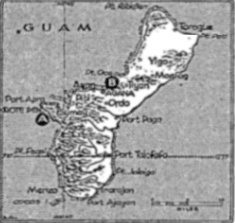The Free Lance-Star (June 22, 1944)
Army and Marines score decisive gains on Saipan
Aboard joint expeditionary force flagship off Saipan, Mariana Islands (AP) –
Japan’s fleet after a week of complex maneuvering is still avoiding surface battle with the powerful U.S. Fleet guarding the Saipan invasion.
The Aslito Airdrome on Saipan, the most valuable in the Marianas and only 1,500 miles from Japan and the Philippines, was ready for operation today after Seabees repaired and extended its 3,600-foot main runway.
Shielded by a great U.S. battle fleet standing off the Marianas, Marines and Army troops launched a major attack this morning to wipe out Japanese defending the island. The situation forced upon Japan’s elusive grand fleet the grimmest challenge yet presented it – to come in and fight.
The enemy fleet, still avoiding battle, had the bitter choice oi fighting or abandoning Saipan’s weakening garrison to destruction.
On Saipan, the U.S. attack began shortly after dawn with veteran forces pushing ahead along a four-mile front extending entirely, across the island from the outskirts of Garapan, main town on the western shore, ands eastward along the slopes of Mount Tapochau to Magicienne Bay on the east coast.
At one point, the Marines advanced one mile in the first three hours. In exactly one week of fighting, the Americans had effected a landing across reefs in the face of extremely heavy fire and had captured the southern third of the island, including two airfields.
One of these fields was Aslito, now ready for operation.
The Japanese, who numbered at least 20,000, fought with ferocity and the advantage of entrenched positions along steep ridges, and made the American advance slow during the first several days. They used batteries of mortars and considerable artillery and employed landmines and booby traps.
One hard-fought battle between Marines and Japanese occurred on a hill overlooking Magicienne Bay, where Japanese artillerymen ran their field pieces in and out of caves firing from outside and ducking back into the mountainside.
The Americans finally captured this and similar positions, killing 75 Japanese in one cave. Flamethrowers were used in destroying enemy mountain strongholds.

